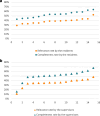Secondary analysis of hand-offs in internal medicine using the I-PASS mnemonic
- PMID: 39334190
- PMCID: PMC11430516
- DOI: 10.1186/s12909-024-05880-7
Secondary analysis of hand-offs in internal medicine using the I-PASS mnemonic
Abstract
Background: Miscommunications account for up to 80% of preventable medical errors. Mnemonics like I-PASS (Illness severity, Patient summary, Actions list, Situation awareness, Synthesis) have demonstrated a positive impact on reducing error rates. Currently, physicians at our hospital do not follow a specific structure during hand-offs. We aimed to compare current hand-offs without prior training to a gold standard and the I-PASS tool in terms of content and sequence.
Methods: This study is a secondary analysis of data collected during a simulation study of a Friday evening hand-off to the night resident at University Hospitals of Geneva. Thirty physicians received a hand-off of four patients and managed two other patients through nursing pages at the start of the night shift, generating six sign-outs each, totaling 177 sign-outs. A focus group of three senior doctors defined the gold standard (GS) by consensus on the essential content of each sign-out. The analysis focused on the rates of relevance (ratio of information considered relevant by the GS) and completeness (proportion of transmitted elements out of all expected elements of the GS), and the distribution and sequence of the first four I-PASS categories.
Results: Relevance and completeness rates were 37.2% ± 0.07 and 51.9% ± 0.1, respectively, with no significant difference between residents and supervisors. There was a positive correlation between total hand-off time and relevance (residents: R2 = 0.62; supervisors: R2 = 0.67) and completeness (residents: R2 = 0.32; supervisors: R2 = 0.56). The distribution of I-PASS categories was highly skewed in both the GS (I = 2%, P = 72%, A = 17%, S = 9%) and participants (I = 6%, P = 73%, A = 14%, S = 7%), with significant differences in categories A (p = 0.046) and I (p ≤ 0.001). Sequences of I-PASS categories generally followed a P-A-S-I pattern. The first S category was frequently absent, and only one participant began by announcing the case severity as suggested by I-PASS.
Conclusion: We identified gaps between current medical sign-outs in our institution's general internal medicine division and the I-PASS structure. We recommend implementing the I-PASS mnemonic, emphasizing the "I" category at the start and the "S" category to anticipate and prevent complications. Future studies should assess the impact of this recommendation, adapt the mnemonic elements to the context, and introduce specific hand-off training for senior medical students.
Keywords: Completeness; Hand-off; I-PASS; Relevance; Sign-out.
© 2024. The Author(s).
Conflict of interest statement
The authors have no competing interests to declare.
Figures







Similar articles
-
Rates of medical errors and preventable adverse events among hospitalized children following implementation of a resident handoff bundle.JAMA. 2013 Dec 4;310(21):2262-70. doi: 10.1001/jama.2013.281961. JAMA. 2013. PMID: 24302089
-
I-PASS enhances effectiveness and accuracy of hand-off for pediatric general surgery patients.J Pediatr Surg. 2022 Apr;57(4):598-603. doi: 10.1016/j.jpedsurg.2021.11.015. Epub 2021 Nov 26. J Pediatr Surg. 2022. PMID: 34911653
-
"PSYCH-PASS": the Development, Adaptation, and Implementation of a Psychiatric Handoff.Acad Psychiatry. 2019 Oct;43(5):503-506. doi: 10.1007/s40596-019-01068-0. Epub 2019 May 1. Acad Psychiatry. 2019. PMID: 31044347
-
A scoping review of clinical handover mnemonic devices.Int J Qual Health Care. 2023 Sep 8;35(3):mzad065. doi: 10.1093/intqhc/mzad065. Int J Qual Health Care. 2023. PMID: 37616494 Review.
-
Year-End Resident Clinic Handoffs: Narrative Review and Recommendations for Improvement.Jt Comm J Qual Patient Saf. 2017 Feb;43(2):71-79. doi: 10.1016/j.jcjq.2016.11.006. Epub 2016 Nov 15. Jt Comm J Qual Patient Saf. 2017. PMID: 28334565 Review.
References
-
- Handoffs and Signouts. PSNet [internet]. Rockville: Agency for Healthcare Research and Quality, US Department of Health and Human Services; 2019.
-
- Starmer AJ, Spector ND, Srivastava R, West DC, Rosenbluth G, Allen AD, et al. Changes in Medical Errors after Implementation of a Handoff Program. N Engl J Med. 2014;371(19):1803–12. - PubMed
-
- Starmer AJ, Sectish TC, Simon DW, Keohane C, McSweeney ME, Chung EY, et al. Rates of medical errors and preventable adverse events among hospitalized children following implementation of a resident handoff bundle. JAMA. 2013;310(21):2262–70. - PubMed
-
- Cohen HG. Medication errors–a system problem. Todays Surg Nurse déc. 1998;20(6):24–8. - PubMed
MeSH terms
LinkOut - more resources
Full Text Sources


